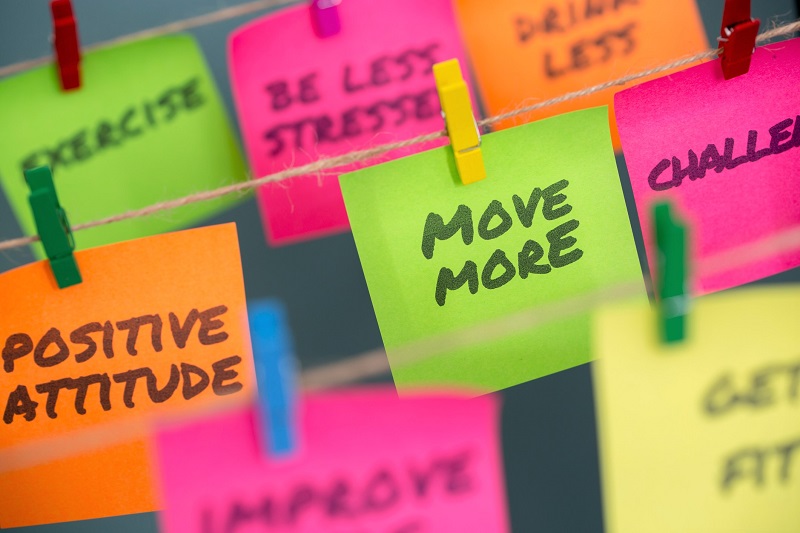Losing weight can sometimes feel like a race. You might find yourself asking, “How much have I lost? Is it more than last week? How can I lose faster?”
These questions can become a distraction. Focusing solely on the number on the scale often shifts your energy toward shrinking that number rather than improving your overall health.
The true goal of weight loss isn’t just about the scale—it’s about feeling your best. By setting health goals that aren’t related to your weight, you can focus on how your daily choices enhance your overall well-being.
Why Set Non-Weight-Related Health Goals?
Health goals provide a clear path toward the life you want to lead. By shifting your focus away from weight and onto more meaningful objectives, you can prioritize what truly matters: boosting energy and stamina to power through your busy days, maintaining strength and mobility as you age, and nurturing your overall well-being—mind, body and spirit.
This guide outlines eight impactful health goals that are not related to weight to help you thrive, and offers practical strategies to turn them into reality!
Goal #1: Increase Daily Energy Levels

Daily life can be demanding, whether you work in the home or on the job. You hope that leaves you with enough in the tank to take part in the fun that life brings your way.
You can get the most out of your life by dialing up your personal energy levels. And you don’t need to guzzle caffeinated drinks to do it!
Here are some tips to naturally increase your energy levels:
- Prioritize Protein: Incorporate protein-rich foods like lean meat, fish, dairy and beans into your meals. These nutrient-packed options provide long-lasting energy to fuel your day. Make sure to include a healthy dose of protein in every meal.
- Stay Hydrated: Dehydration can sneak up on you, often making you feel tired or sluggish before you even feel thirsty. Aim to drink at least 64 ounces of water daily to maintain your energy levels. Hydration doesn’t have to come from plain water—seltzer or herbal teas work just as well.
- Get Quality Sleep: Consistent, restorative sleep is essential for sustained energy. Experts recommend seven to nine hours of sleep each night. If you’re not getting enough rest, your energy will suffer. Establish a sleep routine by going to bed and waking up at the same time each day to feel refreshed and alert.
You’ll notice significant improvements when your energy levels rise. Tasks like walking longer distances without needing a break will come more easily. You may no longer rely on that afternoon coffee pick-me-up, and you’ll find yourself eager to join in activities with family and friends.
Goal #2: Build and Maintain Muscle Strength

Maintaining strength is essential at every stage of life, as muscle mass naturally declines with age. Strength-building isn’t about flexing at the gym—it’s about staying physically capable for everyday activities like carrying groceries, climbing stairs and enjoying the things you love. By building and preserving your strength, you not only keep your body resilient but also enhance muscle tone, helping you look and feel your best along the way.
Check out these tips to build and maintain your muscular strength:
- Lift to Build Strength: The best way to build and maintain muscle is by challenging your body with regular weightlifting. Use light dumbbells, large cans of food or other household items as weights. Bodyweight exercises like push-ups and pull-ups are also highly effective, using your own body as resistance. Start small by performing two sets of 10 repetitions. Gradually increase your challenge every other week by adding more weight or an extra set of reps.
- Strengthen Through Swimming: Swimming is a full-body workout that engages your arms, shoulders, core and legs. Begin with just a few laps in the pool, and aim to add one additional lap each week to build endurance and strength over time.
- Fuel with Protein: Protein is essential for muscle growth and repair. Stick to the recommended servings of PowerFuels on your Nutrisystem meal plan to ensure you’re getting enough of this vital nutrient to support your fitness goals.
Over time, you’ll notice your exercises become easier, signaling that you’re getting stronger. When you’re ready, increase the weight you’re lifting or add more reps to your routine. As your strength improves, you’ll not only see the difference in the mirror but also feel it in everyday tasks, like lifting items that once felt heavy.
Goal #3: Improve Flexibility and Mobility

As you age, your spine and joints naturally lose flexibility, making movement more challenging and less comfortable. However, maintaining your flexibility and mobility throughout life can help you feel better, reduce the risk of arthritis, and lower your chances of falls or injuries. Managing your weight also alleviates pressure on your joints, easing the discomfort caused by stiffness.
- Daily Stretching Routine: Incorporate daily stretching into your routine. Learn how to stretch the right way with our simple guide.
- Low-Impact Activities: Consider incorporating low-impact exercises like yoga into your routine to further enhance flexibility. Yoga provides numerous benefits, starting with improved range of motion. If you’re new to it, try an introductory class or follow a beginner-friendly video, such as this 10-minute morning routine. Other excellent options include Pilates and tai chi, both of which improve mobility and flexibility without putting excessive strain on your body.
Over time, you’ll notice the results of your efforts. When you wake up in the morning, you’ll feel less stiff, and your daily stretching routine will help you move through your day with ease. Better flexibility means fewer aches and greater comfort, allowing you to live life more fully.
Goal #4: Enhance Mental Clarity and Focus

When you’re sleep-deprived or overwhelmed by stress, your ability to think clearly and stay focused diminishes. Boost your mental clarity and concentration with these effective strategies:
- Practice Mindfulness: Mindfulness is the art of bringing your attention to the present moment, wherever you are and whatever you’re doing. It’s about letting go of intrusive thoughts—everyday worries or big-picture concerns—and tuning into your feelings. Simply breathe naturally, focusing on each inhale and exhale. Dedicate just 10 minutes a day to this practice, and you’ll strengthen your ability to block out distractions when it’s time to focus.
- Eat Brain-Boosting Foods: What you eat fuels not just your body but also your brain. Leafy greens, omega-3-rich fish like salmon and tuna, and walnuts are known to enhance cognitive function, according to Harvard Medical School. These foods don’t just sharpen your mind—they’re also great for weight loss, making them a win-win for your health and mental performance.
- Stay Active: Exercise is closely linked to improved cognitive ability, particularly when it comes to attention and focus, as noted in the journal Comprehensive Psychology. Physical activity promotes the production of brain chemicals that foster new neural connections, lower stress levels and improve sleep quality. A simple 30-minute walk or other daily exercise can sharpen mental clarity while supporting your weight loss goals.
Distractions can make completing tasks feel like an uphill battle. As you work through your to-do list, take note of how many tasks you fully complete versus those left unfinished due to wandering attention. With these strategies in practice, you’ll find yourself tackling each task with greater focus and efficiency, crossing off your list with confidence. You can enhance your mental focus and achieve a healthier, more productive lifestyle.
Goal #5: Support Gut Health

A healthy gut is key to feeling great and supporting your immune system. Your digestive tract is home to a diverse community of microbes that break down food, absorb nutrients and help protect your body from harmful germs. To keep these essential microorganisms thriving, you need to give them the nutrients they need to do their job.
- Probiotic Foods to Boost Your Gut Health: Probiotic-rich foods like plain Greek yogurt, sauerkraut, pickles and kombucha help replenish the good bacteria in your gut. Adding these fermented foods to your daily meals can improve digestion and overall gut health.
- Prebiotic Foods to Fuel for Good Bacteria: Prebiotic foods are high in fiber and act as fuel for your gut microbes. Great options include whole grains, bananas, leafy greens, garlic, onions, soybeans and artichokes. A diet rich in prebiotics helps nourish the bacteria that keep your digestive system running smoothly.
Pardon us, but the best place to tell if your gut is healthy is in the bathroom. Regular and balanced bowel movements indicate a healthy digestive tract, while frequent constipation or diarrhea may signal a problem. Speak to your healthcare provider if you have questions or concerns. You may need to optimize your gut health with the right balance of probiotics, prebiotics and healthy habits to keep your digestion and immune system in top form!
Goal #6: Manage Stress Effectively

We all have stress in our lives, but how you deal with it has a serious impact on our health. When we’re overstressed, we don’t sleep well and are prone to eating unhealthy food. Chronic stress can contribute to serious health problems like high blood pressure. Use these practices to help you process stress without letting it overwhelm you.
- Practice Mindful Breathing: Find a comfortable, upright position—sit with your back straight but relaxed. Rest your hands on your knees or lap. Gently shift your attention to each part of your body, from your feet to your scalp, and release any tension you notice. As you breathe naturally, focus on the rhythm of your breath. Inhale fully and exhale fully, noting how the tension leaves your body with each breath. This simple practice can calm your mind and help you feel grounded.
- Try Moving Meditation: Sitting still is not the only way to practice mindfulness. You can also meditate as you walk. Breathe deeply as you move and tune into the feelings in your body. Focus your awareness on the sensations without thinking about what to do with them. As you begin to move, complete each step with your full weight before shifting the weight to take the next step. Breathe deeply as you walk, focusing on the sensations in your body. Let your worries fade with each step as you establish a calming rhythm.
- Go Dancing: Activity of any kind can help release the pressures of stress, but dancing appears to be especially beneficial, according to researchers at Rutgers University. They report that dancing increases your body’s production of serotonin, a compound in the brain that relaxes you and puts you in a happy mood. You can move to any type of music you like and dance in any way that you enjoy. Invite a partner to join you and both of you can enjoy the benefits and the time together.
While you can’t eliminate stress entirely, managing it well can lead to noticeable improvements in your life. By using these techniques, you can take control of stress and prioritize your mental and physical health. You’ll sleep better, avoid stress-induced cravings, and reduce headaches, neck and back tension. Pay attention to how you feel in stressful situations—if you’re staying calm and balanced, you’re on the right track.
Goal #7: Prioritize Quality Sleep

Sleep isn’t just a way to recharge after a busy day—it’s essential for your physical and mental health. Poor sleep can lead to serious health problems over time. While you rest, your body reduces stress hormones that can harm your brain and overall well-being. Use these tips to improve the quality of your sleep.
- Stick to a Sleep Schedule: Your body thrives on a consistent routine. Try to wake up and go to bed at the same time every day, even on weekends. If your schedule gets disrupted, return to your routine as quickly as possible to avoid falling into irregular sleep patterns.
- Limit Screen Time Before Bed: Scrolling on social media right before lights out can generate anxiety or other kinds of stress. What’s more, the blue light emitted by screens, including the TV, may reduce your body’s supply of melatonin, the sleep hormone. Set aside electronics 30 minutes before you’re ready to sleep. If you need to occupy your mind before bedtime, reading can be helpful.
- Create a Comfortable Sleep Environment: Your bedroom should be cool, dark and quiet for optimal sleep. Most people sleep best in temperatures between 60 and 65°F. If outside light bothers you, use blackout curtains or a sleep mask. White noise machines or soothing sounds can help block out disruptive noises around you.
- Avoid Late-Day Caffeine: Consuming coffee, tea and other caffeinated drinks later in the day can make falling asleep harder for you. If you have noticed you have trouble dozing off when you go to bed, avoid caffeine in the afternoon and evening.
- Get Some Sunlight: Exposure to sunlight triggers the release of critical hormones in your body that affect your sleep patterns. Try to get outside for a little sunshine each day.
Occasional restless nights happen, but if you consistently struggle to get quality sleep, it’s time to focus more on these strategies. Commit to improving your sleep and notice the difference it can make in your overall health and energy levels.
Goal #8: Build a Positive and Healthy Relationship with Food

Food is more than just fuel—it’s nourishment, joy and a way to connect with yourself and others. But for many, balancing eating habits can feel overwhelming. By cultivating a positive relationship with food, you can make choices that nourish your body, uplift your mind and boost your confidence—without stress or guilt.
- Listen to Your Hunger: It might sound simple, but eating when you’re hungry is key. When trying to lose weight, skipping meals and ignoring hunger cues can backfire, often leading to overeating or unhealthy choices later. Honor your hunger, and give your body what it needs.
- Plan Ahead for Success: When hunger strikes and you’re unprepared, unhealthy convenience foods can feel like the only option. Avoid this by planning your meals in advance. Start each day—or better yet, the week—with a plan and stock up on the ingredients you’ll need. A little prep goes a long way in helping you stay on track.
- Choose Foods You Love: Healthy eating doesn’t mean forcing yourself to eat foods you dislike. Instead, focus on finding healthy options you genuinely enjoy. Don’t love certain vegetables? Experiment with new ones or try different preparations—cooked, raw, roasted—you might discover a version you love.
- Treat Yourself: Depriving yourself of your favorite treats isn’t sustainable. Love ice cream or pizza? Enjoy a small portion now and then. Satisfying your cravings in moderation can help prevent overindulgence and keep you balanced. Consider stocking up on portion-controlled versions of these treats from the Nutrisystem menu!
- Let Go of Guilt: Nobody eats perfectly all the time—and that’s okay. If you have a meal (or even a day) that doesn’t align with your healthy eating plan, don’t beat yourself up. Let go of guilt, and focus on making choices you feel good about in your next meal or the next day. Building a positive relationship with food is a journey, not a race
Before you eat, check in with yourself: Does this meal align with my healthy eating goals? Am I excited about it? Will it satisfy my hunger? If the answers are yes, you’re on the right path to nurturing a balanced, healthy relationship with food. Celebrate your progress and enjoy the journey!
How to Set and Track Meaningful Health Goals (Beyond the Scale)

Achieving your goals starts with setting them and tracking your progress. The key is to be realistic and intentional, so your goals feel attainable and motivating. A great approach is to use the SMART method: Specific, Measurable, Achievable, Relevant and Time-Bound.
Make your goals clear and actionable. For example, instead of saying, “I’ll eat healthier,” try “I’ll eat four servings of vegetables every day” or “I’ll walk for 30 minutes daily.” Keep them realistic and within reach so you can stick to them without feeling overwhelmed. Your goals should connect to your bigger picture of improving your overall well-being. Adding a timeline allows you to measure progress and celebrate milestones along the way.
Accountability is key! Write your goals down and check in with them often. Whether you use a health journal, a phone app or a simple calendar, tracking your progress helps you stay committed and see how far you’ve come. Get our guide to setting SMART goals here!
Celebrate small wins—each one is a step closer to your larger goal. Reward yourself with positive encouragement and stay motivated to keep moving forward. Every effort counts in your journey to better health and well-being!

